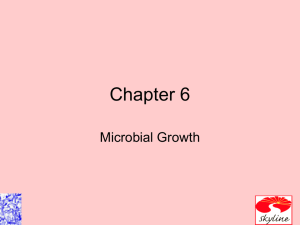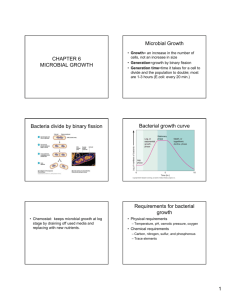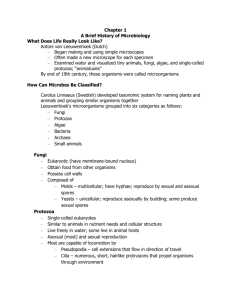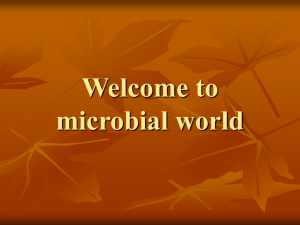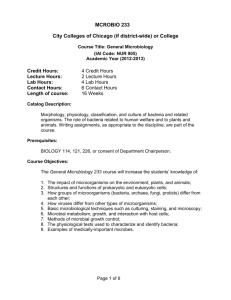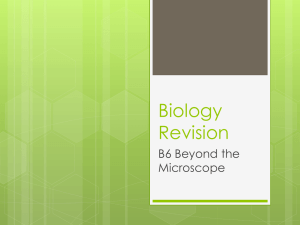Microbiology Video Assignment: Unseen Life on Earth
advertisement
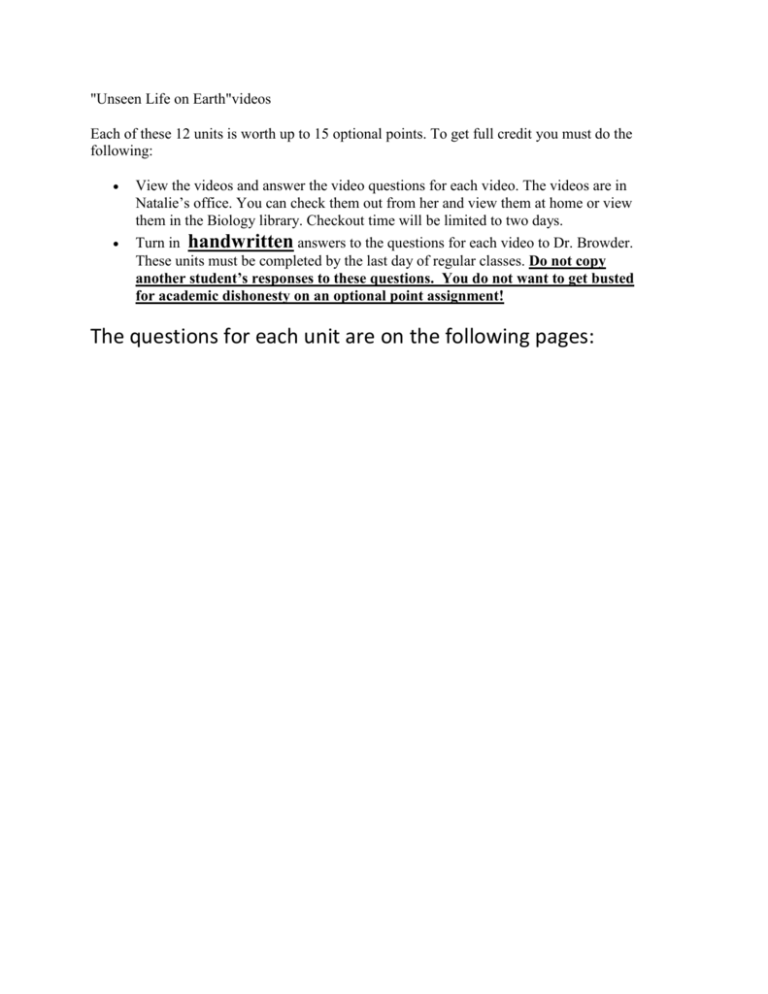
"Unseen Life on Earth"videos Each of these 12 units is worth up to 15 optional points. To get full credit you must do the following: View the videos and answer the video questions for each video. The videos are in Natalie’s office. You can check them out from her and view them at home or view them in the Biology library. Checkout time will be limited to two days. Turn in handwritten answers to the questions for each video to Dr. Browder. These units must be completed by the last day of regular classes. Do not copy another student’s responses to these questions. You do not want to get busted for academic dishonesty on an optional point assignment! The questions for each unit are on the following pages: UNIT 1: The Microbial Universe VIDEO QUESTIONS: 1. When did humans become aware of the existence of microorganisms? 2. What is the ecological role of most bacteria? 3. Cellulose is the primary carbohydrate found in plants, and animals cannot digest cellulose. How can cows, bison, giraffes, moose, and termites live and grow by eating only plant matter? 4. Your body harbors how many times as many microbial cells as human cells? 5. What differentiates cyanobacteria from most other bacteria? 6. Molecular oxygen (02) is produced by what types of organisms? 7. Why are microorganisms essential to life (what are their beneficial activities)? 8. What is SAR 11? What is its ecological significance? 9. Why is it important for researchers to be able to grow SAR 11 in the lab? Is it unusual that it won't grow in the lab? Why is it difficult to grow this organism in the lab? Unit 2: The Unity of Living Systems VIDEO QUESTIONS: 1. How can you distinguish between the prokaryotic and eukaryotic cells shown in the video? Characterize the bacteria shown in the video according to morphology: bacilli, cocci, or spirilla. 2. Why do the following provide evidence of evolution? The presence of DNA in cells. The presence of the same genes in bacteria and humans. 3. Which evolved first, a virus or its host cell? 4. Are viruses alive? 5. The following statement is made in the video: "What microbes are ultimately telling us is that each of us contains within our genetic material a written history of life on Earth." Briefly explain the statement. 6. If genes were equally distributed on each chromosome, how many genes would each human chromosome carry? 7. Of what value to humankind is the human genome project? Unit 3: Metabolism VIDEO QUESTIONS: 1. This video begins with a microscopic view of a growing colony of bacteria. What shape are the bacteria? ______________________ 2. Write definitions of the following terms as you watch the video: a. Anabolism. b. Catabolism c. Chemolithotrophy d. Fermentation e. Photosynthesis f. Respiration 3. The source of energy for primary producers such as plants and photosynthetic bacteria is______________________________________? . What are the primary producers in a deep-sea food chain? What do these organisms use for an energy source? 4. Why do yeast make beer? 5. What is happening in each of these places in a sewage treatment plant? Which steps require air (02)? Where does the effluent go at step 1? Where does the waste go at step 2? 6. Why does this video include a study of sewage treatment and beer making? Unit 4: Reading the Code of Life VIDEO QUESTIONS: 1. Consider the phrase "And in 50 years' time, microbes have learned how to live with them [antibiotics]." Discuss whether the microbes have learned or have been selected. 2. 3. 4. List the factors that contribute to the selection of antibiotic-resistant bacteria. Why do we see mutant bacteria more often than mutant animals? Is all DNA in a cell active all the time? 5. Jim Leinfelder refers to the thermostat in the house. How is feedback repression like the thermostat? UNIT 5: GENETIC TRANSFER VIDEO QUESTIONS: 1. Write definitions of the following terms as you watch the video: a. Transduction. b. Conjugation. c. Transformation. d. Transposition. 2. Compare and contrast vertical and horizontal gene transfer. 3. What vector does Victor Masona use to engineer cassava plants? 4. What is phage conversion? 5. Conjugative plasmids are transferred from one cell to another by conjugation. How can nonconjugative plasmids be transferred? Unit 6: Microbial Evolution VIDEO QUESTIONS: 1. How do the chemolithotrophs in the thermal vents get energy from H2 and use sulfur instead of oxygen? 2. Why can you assume that there are microorganisms in the sample Stetter collected from the vent? 3. Classification is based on ribosomal RNA. What is the function of ribosomes? Why do all organisms have ribosomes? 4. Why do we need to use rRNA sequencing; what's wrong with using observation as Linnaeus. Charles Darwin, and Louis Pasteur did? 5. What percentage of a human's genes are the same as the genes of a whale, a dog, and a three-toed sloth? Why? 6. What does Stetter mean when he says "the hotter the temperature, the deeper the branches go"? 7. If all organisms evolved from a common ancestor, how do you account for the diversity of life on Earth? Unit 7: Microbial Diversity VIDEO QUESTIONS: 1. Why does a microbiologist study termites? 2. How is PCR used to identify microorganisms? 3. Now that we have PCR, why do we use culture techniques? 4. Identify some of the unusual habitats occupied by microorganisms. 5. Which of the following is correct? Briefly explain why. a. When an antibiotic is introduced, sensitive bacteria will develop resistance. a. When an antibiotic is introduced, resistant bacteria will survive and reproduce. 6. Why aren’t viruses included in the tree of life? Unit 8: Microbial Ecology 1. Differentiate between light and dark clouds. How does this affect the Earth’s temperature? How do microbes contribute to the cloud color? 2. Why did Biosphere II fail? Use BOD in your answer. 3. What does Hazen add to the landfill to promote microbial growth? 4. What causes the high temperature in Hazen’s landfill experiment? Unit 9: Microbial Control VIDEO QUESTIONS: 1. Write definitions of the following terms as you watch the video: a. Disinfection a. Antisepsis a. Sterilization 2. Describe the four levels of precautions in the clinical infection control program and explain when each is used. a. Level 1 a. Level 2 a. Level 3 a. Level 4 3. What precautions should be taken in the home kitchen while preparing food? 4. What reasons are given by Hanquet for the prevalence of infectious diseases? Unit 10: Microbial Interactions VIDEO QUESTIONS: 1. Why can microbes be described as “masters of life on Earth”? 2. Does the cow actually do pregastric fermentation? 3. Methane is produced in the cow’s rumen. What organisms use the methane? 4. What did Terry Hazen pump into the ground at the Savannah River site? Why did he add methane if he wanted the bacteria to use the chloroethylene compounds? 5. What percentage of O2 in the atmosphere is produced by terrestrial plants? By microorganisms? Which microbes produce O2? Unit 11: Human Defenses VIDEO QUESTIONS: 1. Discuss several reasons why we don’t vaccinate against all diseases. 2. Discuss what’s wrong with this statement: Bacteria enter cells in order to avoid phagocytosis. 3. Why don’t newborns and adults get “childhood” diseases such as measles, mumps, and chickenpox? 4. The video shows a photograph with the legend “Chemotaxis of neutrophils.” What does this mean? 5. In the video, Fleming says that smallpox has been eliminated. How was this accomplished? 6. Fleming lists some reasons why preventable diseases are still occurring in developing countries. What are the reasons? 7. Why are some preventable diseases still occurring in developed countries (e.g., measles in the U.S. diphtheria in eastern Europe)? Unit 12: Microbes and Human Disease VIDEO QUESTIONS: 1. In the video, you learned that each of five outbreaks of English sweating sickness stopped inexplicably. How does an epidemic stop without medical intervention (e.g., vaccination, chemotherapy, quarantine)? 2. Identify factors that contribute to the emergence of infectious disease. 3. Explain Jim Leinfelder’s statement “Humans are not a good host for Hantavirus...yet.” Use the 1996 outbreak of Hantavirus in Argentina to explain the difficulty viruses have crossing a species barrier. (That is, most viruses infect only one or two different host species.) 4. Do microbes “plan” to cause disease? 5. The three methods used in epidemiology are descriptive, analytical, and experimental. Match the three examples in the video to the epidemiological method used. 6. The diseases (or their causative agents) listed below are mentioned in this video. Using your textbook, identify the following information for each diease: Causative Agent (is it Bacteria, Protozoan, Virus, or Fungus?), Gram Reaction (if Bacterial) , Organ/System Affected , Method of Transmission, and Treatment. Diseases: A. gonnorhea B. yest infection C. Salmonellosis D. Ebola hemorrhagic fever E. Influenza F. AIDS G. Legionnaires’ disease H. Hantavirus pulmonary syndrome I. Plague J. Systemic plague K. Anthrax
